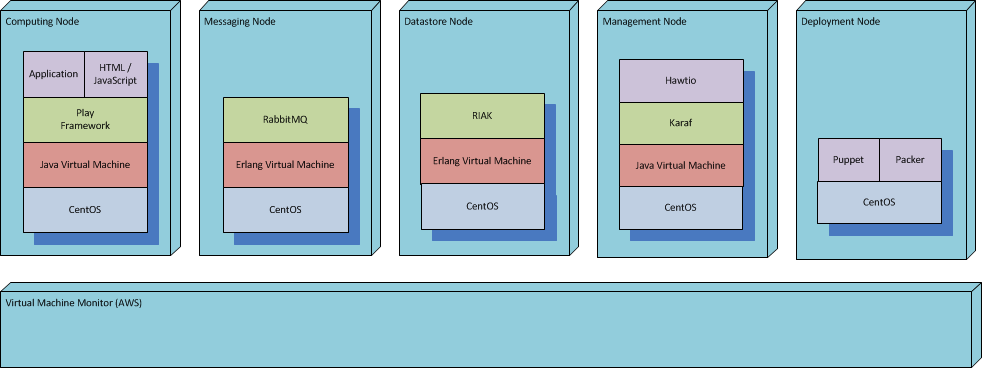Difference between revisions of "Node Architecture For Enterprise"
(→Cloud) |
(→Monitoring) |
||
| Line 35: | Line 35: | ||
= Monitoring = | = Monitoring = | ||
| − | |||
With a system landscape consisting of nodes in clusters monitoring occurs at two levels: | With a system landscape consisting of nodes in clusters monitoring occurs at two levels: | ||
| − | + | - At node level with each node exposing monitoring information through a monitoring agent. A surveillance / monitoring tool used by IT operations can collect the information provided by the monitoring agent | |
| − | + | - An aggregated view of the cluster of nodes, displaying the overall state of the cluster of some node. The monitoring aggreate is hosted by the "Management Node" | |
| − | The external | + | The external interface of a monitoring agent is provided by http://jolokia.org, which exposes JMX MBean information via a JSON over HTTP. Jolokia is packaged within Hawtio, which additionally provides a Web UI to the JMX MBean information that jolokia provides. Thus each node as well as the aggreated information is available via a web-browser through Hawtio. |
For non-java applications like RabbitMQ and RIAK, there is a need for a java client that can collect relevant information regarding the applications health state which can be exposed using jolokia and Hawtio. | For non-java applications like RabbitMQ and RIAK, there is a need for a java client that can collect relevant information regarding the applications health state which can be exposed using jolokia and Hawtio. | ||
= Deployment = | = Deployment = | ||
Revision as of 16:57, 16 March 2014
This page describes the overall technology stack used within the IB appliance, and to some degree also within the supporting business systems.
Contents
Overview
The diagram below gives an overview of the technologies used in the different nodes.
Guiding Principles
The main guiding principle, for choosing technologies is that:
We want to have has few technologies as possible, yet for each problem we want to have the best possible technology.
- We want few technologies, because the fewer we have, the easier they are to master. At the same time we want the best technologies, because they solve our problems in the most efficient way.
- We should never have two different technologies for solving the same problem.
Cloud
The entire enterprise IT, i.e. both AccountIT as well as Internal systems will be run "in the cloud". The primary reason for this is the lack of own data-center where the systems can be hosted. As cloud data-centers are lease based, it is essential that the all systems (AccountIT as well as business systems) must be horizontally scalable ("elastic scaling") such that the systems can "scale down" i.e. reduce the use of "HW" resources like CPU, memory, hard-disk and network. Scaling must be automatic to provide with a "24 / 7" illusion to the user, while keeping the cost of leasing the "HW" resources is kept to a minimum. "HW" in this context is virtual as it is provided by a "Cloud provider" like Amazon WebServices.
Play Framework
The AccountIT application will be based on the Play Framework. Play provides a UI framework that has support for HTML5 and JavaScript making it possible to provide a modern web-application feel. The framework provides a developer friendly environment making it easy to develop and test - this is the primary reason for choosing this framework. Development can be done in both Java and Scala - giving possibility to mix Object Oriented with Functional Programming.
Messaging
Messaging is used to build a asynchronous system based on the CQRS pattern. The commands represent update requests, while query represent search requests. RabbitMQ will also be used to integrate between AccuntIT and supporting business systems (such as CRM, ERP, support and sales systems). But also between supporting business systems.
Datastore
Monitoring
With a system landscape consisting of nodes in clusters monitoring occurs at two levels: - At node level with each node exposing monitoring information through a monitoring agent. A surveillance / monitoring tool used by IT operations can collect the information provided by the monitoring agent - An aggregated view of the cluster of nodes, displaying the overall state of the cluster of some node. The monitoring aggreate is hosted by the "Management Node"
The external interface of a monitoring agent is provided by http://jolokia.org, which exposes JMX MBean information via a JSON over HTTP. Jolokia is packaged within Hawtio, which additionally provides a Web UI to the JMX MBean information that jolokia provides. Thus each node as well as the aggreated information is available via a web-browser through Hawtio.
For non-java applications like RabbitMQ and RIAK, there is a need for a java client that can collect relevant information regarding the applications health state which can be exposed using jolokia and Hawtio.
